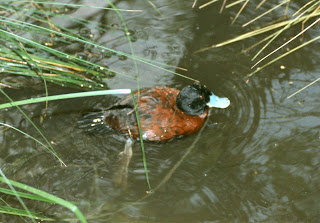James drove me down. He'd seen the bird before, but wanted to get better photos. I just wanted to add the bird to my list. We arrived at about 11. It was very hot. There were very few people looking for the bird. I think I saw four cars. For a January twitch so close to Melbourne, I'd have expected many more. I suppose everyone had seen the bird over the weekend.
 |
| James at Lake Murdeduke |
Thanks to social media, we knew where the bird was before we arrived. It was on the shore, just before the sandspit, some half an hour's walk. We parked and set off, trudging across the paddocks. A Brown Songlark, some skylarks and several pipits entertained us as we walked, and took our minds off the heat. Some Banded Stilts shimmered in the far distance, almost on the other side of the lake. Along the shoreline, Red-necked Stints, Red-capped Plovers, Sharp-tailed and Curlew Sandpipers, foraged, oblivious of the heat. One Red-necked Avocet flew away, showing its pretty upperwing pattern.
At 11.30, we started looking seriously at the waders. The light wasn't good, but it only took about ten minutes before James' sharp eyes spotted our quarry. Yippee! Number 802.
 |
| Buff-breasted Sandpiper, photo by James Mustafa |
The bird walked quite fast, along the shoreline and into the grass. It is moulting, so it will probably be around Lake Murdeduke for a while. While it is called 'buff' breasted, I would have called the colour pale orange. We could see its yellow legs and whitish eye-ring.
We came home quite pleased with ourselves. James had some nice photos, and I had my third lifer for 2017, and it's still only January.






